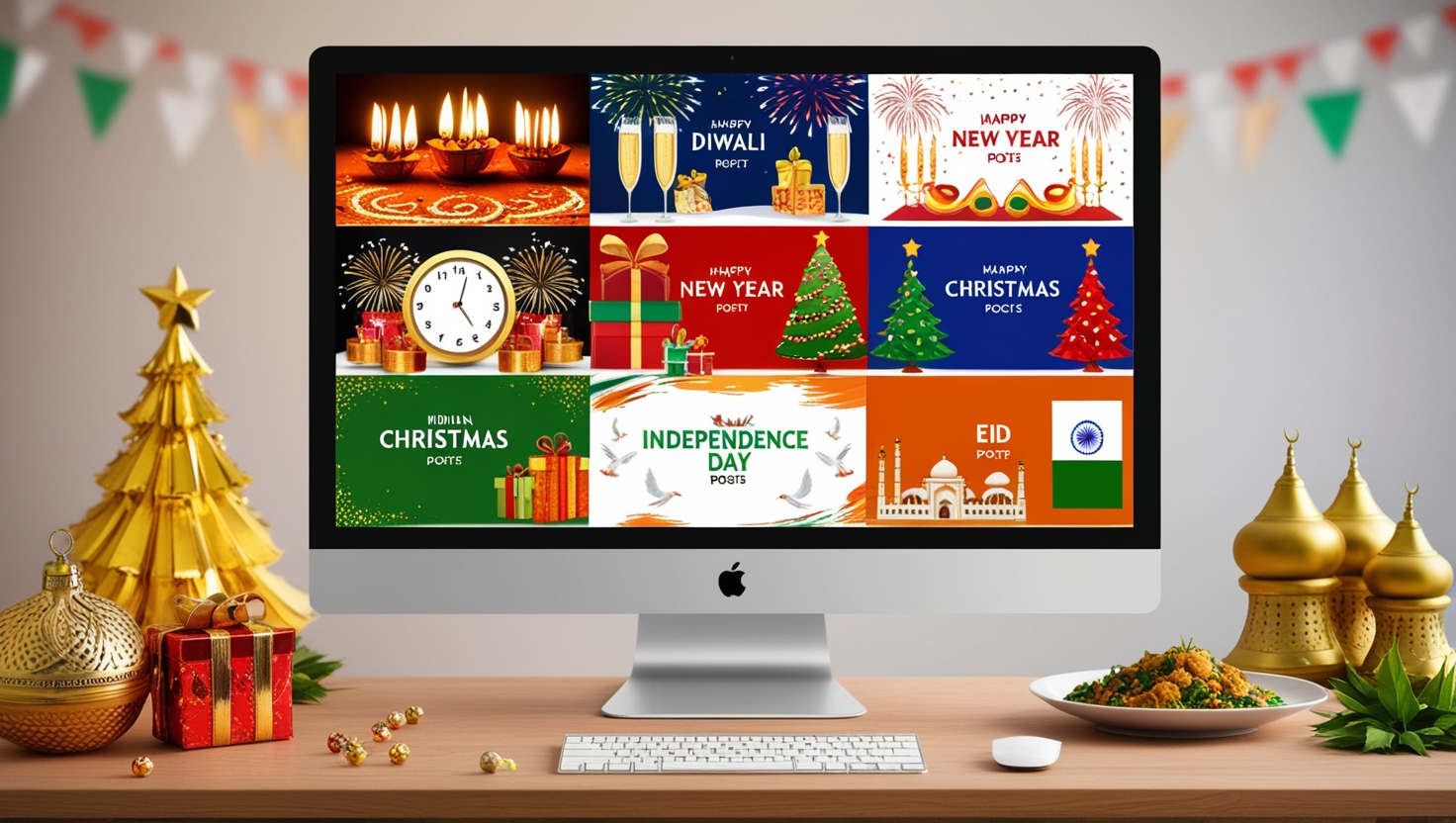Key Takeaways
- Festival posts on social media can boost engagement and brand visibility but carry risks if not handled well.
- Thoughtful planning, authenticity, and cultural sensitivity are key to successful campaigns.
- High-quality visuals and a well-researched content calendar can set your brand apart.
Introduction
Festival-themed posts are increasingly becoming a staple on social media. From vibrant Diwali posts to heartfelt Christmas greetings, brands are leveraging festivals to connect with audiences. However, while this strategy offers growth opportunities, it also comes with challenges. Let’s explore the pros, cons, and actionable steps for creating impactful festival posts.
Pros of Festival Posts
- Increased engagement and reach: Festivals are naturally engaging periods as audiences are in a celebratory mood. A brand posting vibrant Diwali visuals, for instance, can attract likes, shares, and comments, amplifying organic reach.
Example: Zomato’s creative Diwali campaigns often use food puns paired with festival themes, encouraging users to engage and share their content widely. - Brand awareness and visibility: Posting during festivals allows brands to stay relevant and be seen by a broader audience who are actively browsing festive content.
Case Study: Coca-Cola’s Christmas campaigns, like the famous “Holidays Are Coming” truck, consistently build awareness and evoke nostalgia, making their brand synonymous with the season. - Opportunity to showcase brand personality: Festival posts can reflect a brand’s values, creativity, and personality. A quirky or heartfelt post lets audiences see the human side of your business.
Example: Amul’s topical festival advertisements, blending humor with current events, have become iconic for showcasing the brand’s wit and relatability. - Connecting with the audience: By acknowledging and celebrating festivals, brands foster a deeper emotional bond with their audience.
Example: Tanishq’s “Ekatvam” campaign during Diwali highlighted unity and tradition, resonating emotionally with a diverse audience. - Potential for increased sales: Festivals are peak shopping periods, and festive-themed promotions can drive direct sales.
Case Study: Amazon’s “Great Indian Festival” sale aligns its marketing strategy with the festive shopping spree, offering exclusive deals and boosting sales significantly.
Cons of Festival Posts
- Risk of appearing insensitive: Festival campaigns need cultural awareness. Missteps, like using stereotypes or trivializing traditions, can lead to public backlash.
Case Study: A jewelry brand’s ad during Diwali faced criticism for appearing to misrepresent religious sentiments, showing how poorly executed campaigns can hurt a brand’s reputation. - Content saturation: With so many brands posting similar content during festivals, standing out becomes a challenge.
Example: During Christmas, brands often flood social media with red-and-white visuals, making unique campaigns difficult to notice unless exceptionally creative. - Irrelevance: Some festivals may not resonate with your audience. For example, a brand targeting a global audience may find it challenging to focus on region-specific festivals like Onam or Pongal.
Suggestion: Carefully analyze your audience demographics before diving into niche festivals. - Execution challenges: Poorly planned campaigns, whether rushed designs or incorrect hashtags, can diminish impact.
Example: A brand that misused a popular festival hashtag received criticism for being opportunistic and out of touch.
What to Do?
- Understand your audience: Use social media analytics to determine if your audience actively engages with festival content. Study past performance and trends.
Example: If your audience showed high engagement on Holi-related posts last year, consider doubling down on similar content this year while experimenting with fresh ideas. - Be authentic and respectful: Ensure your posts reflect your brand’s values and show genuine appreciation for the festival. Avoid appropriating or stereotyping traditions.
Case Study: Starbucks India’s Raksha Bandhan campaign focused on sibling bonds rather than overt product promotions, aligning with their ethos of fostering human connections. - Plan ahead: A content calendar lets you brainstorm creative ideas, ensure timely delivery, and avoid last-minute errors. Incorporate deadlines for design, approvals, and posting schedules.
Example: Nestlé planned a month-long Christmas campaign featuring recipes and contests to keep their audience engaged throughout the festive season. - Be creative and original: Avoid generic “Happy [Festival Name]” posts. Instead, explore unique storytelling or visually engaging content.
Case Study: Swiggy’s Holi-themed “Order colors of joy” campaign combined clever wordplay with vibrant food-themed graphics, setting it apart. - Use high-quality visuals: Eye-catching images and videos enhance user engagement. Consider investing in professional content creation tools or services.
Example: Airbnb’s Diwali campaign showcased stunning images of beautifully lit homes and user-generated stories, creating a warm and personal touch. - Track your results: Use metrics like reach, engagement, and click-through rates to evaluate your campaign’s success. Adjust your strategy for future campaigns based on these insights.
Case Study: A clothing brand noticed better performance with posts featuring user-generated content and shifted focus accordingly for future campaigns.
Conclusion
Festival posts are a double-edged sword. While they offer immense potential for engagement and connection, they require careful execution to avoid pitfalls. By planning thoughtfully, staying authentic, and tracking results, you can make the most of festival campaigns.
Need guidance to create impactful festival campaigns? Let’s connect and bring your brand to life.


Leave a Reply